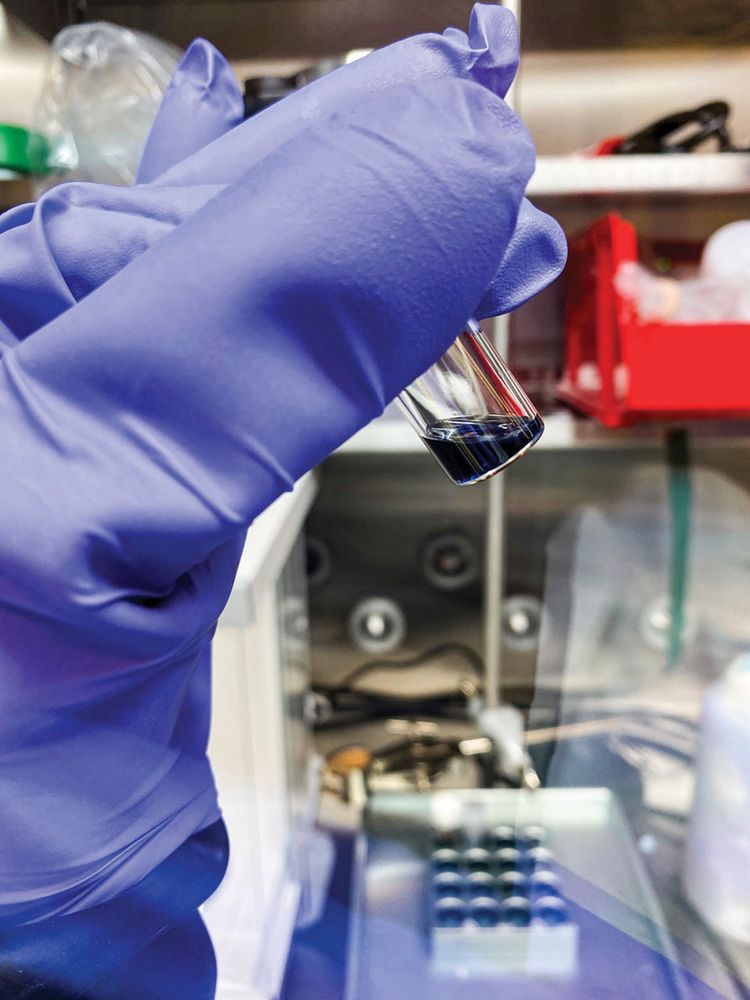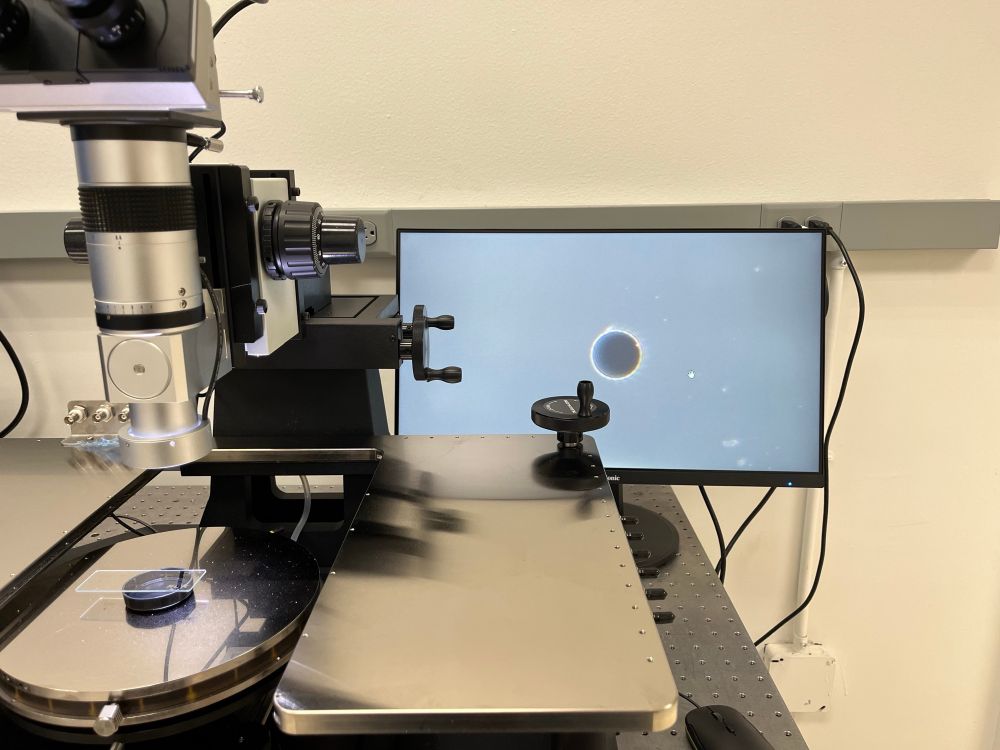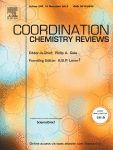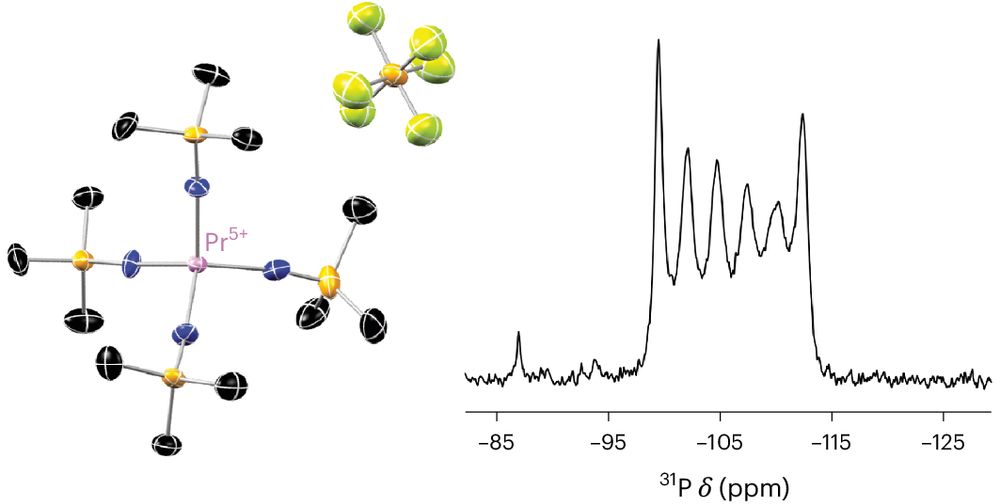
P4 REDUCTION generally results in multi-nuclear Zintl anions: P8(2-), P4(2-) or P7(3-). Reaction with a soluble Mg(0) complex gave full reduction to P(3-). Latter anion serves as a triple base, a three-fold nucleophile or 3e-reducing agent. onlinelibrary.wiley.com/doi/epdf/10.10
02.09.2025 10:31 — 👍 43 🔁 10 💬 0 📌 0
A new water stable carbene validates a hypothesis put forward almost 70 years ago by the famed organic chemist Ronald Breslow.
www.chemistryworld.com/news/super-s...
25.05.2025 09:01 — 👍 10 🔁 2 💬 0 📌 0
Yep
16.05.2025 15:35 — 👍 0 🔁 0 💬 0 📌 0

Porphyrin-based organic materials have exciting optical properties and wide applications. In this study, the authors report a B(III) complex of a new sub-m-benziporphyrin with an unusual planar tridentate 14π-aromatic network.
Read it for free 👉pubs.rsc.org/doi/D4S...
#ChemSky
12.05.2025 13:04 — 👍 9 🔁 2 💬 0 📌 0
Congratulations!!!
06.05.2025 01:42 — 👍 1 🔁 0 💬 1 📌 0

Carbon–boron triple bond formed for the first time in a neutral novel molecule
Synthesis could help chemists better understand bonding
Researchers have synthesised a triple bond between carbon and boron for the first time, in a discovery that could inspire other researchers to synthesise compounds that might seem improbable.
13.03.2025 17:31 — 👍 18 🔁 6 💬 0 📌 0

Insights into the Complexation of Actinides by Diethylenetriaminepentaacetic Acid from Characterization of the Americium(III) Complex
Diethylenetriaminepentaacetic acid (DTPA) is a frequently used chelator in the nuclear and medical industries, especially for the complexation of trivalent actinides. However, structural data on these complexes in the solid-state have long remained elusive. Herein, a detailed structural analysis of the presented crystal structures of [C(NH2)3]4[Nd(DTPA)]2·nH2O and [C(NH2)3]4[Am(DTPA)]2·nH2O, where [C(NH2)3]+ is guanidinium, details the subtle differences in the Lewis acidity between a lanthanide/actinide pair of similar ionic sizes. Contractions in nitrogen–metal bond lengths between neodymium(III) and americium(III) were observed, while the metal–oxygen bonds remained relatively consistent, highlighting the marginal favorability for actinide complexation over the lanthanides with moderately soft N-donors. Spectroscopic analysis shows significant splitting of many transitions and relatively strong electronic interactions with traditionally low-intensity transitions in the americium complex, as is demonstrated in the 7F0→7F5 transitions. Pressure-induced spectroscopic analysis showed surprisingly little effect on the americium complex, with 5f→5f transitions either not shifting or marginally shifting from 2 to 3 nm at 11.93 ± 0.06 GPa─atypical of a soft, N-donor americium complex under pressure. Large voids occupied by water molecules in between the complexes within the crystal structure may be responsible for the lack of pressure response in the 5f→5f transitions.
This is a heavy hitting americium structure great job brian! @teasactinides.bsky.social pubs.acs.org/doi/10.1021/...
12.03.2025 22:42 — 👍 7 🔁 1 💬 0 📌 0
That’s brave chemistry.
12.03.2025 02:56 — 👍 1 🔁 0 💬 0 📌 0

This vial holds a few drops of a solution of berkelocene, which delivered tiny indigo crystals of the new complex.
It is a sandwich with the rarest of fillings. Researchers have unveiled berkelocene, a compound containing the synthetic element berkelium nestled neatly between two ring-shaped molecules. cen.acs.org/analytical-c... #chemsky🧪
02.03.2025 21:11 — 👍 42 🔁 9 💬 0 📌 3
That’s really cool!
17.02.2025 16:25 — 👍 1 🔁 0 💬 0 📌 1

PREFORMED REDOX-ACTIVE INVERSE CROWNS: Finally out in @naturechemistry.bsky.social Highly selective reduction of N2O, epoxide, sulfur or O2. The ring can also be extended to a larger metalla-crown for stabilization of larger anions like N2O2(2-). Open access: shorturl.at/LZE6Y
17.02.2025 16:22 — 👍 58 🔁 11 💬 3 📌 0

I’ll never get used to this. From left to right: John Wagner, Director of Idaho National Laboratory. Katy Huff, former assistant secretary for nuclear energy. Some random guy they grabbed off a hiking trail. Rita Baranwal, VP at Westinghouse #AAAS #nuclear #fblockrocks #ChemSky
16.02.2025 14:05 — 👍 7 🔁 0 💬 2 📌 0
My dad did his postdoc with Enders.
14.02.2025 18:51 — 👍 1 🔁 1 💬 0 📌 0
Looking forward to tomorrow’s panel.
14.02.2025 18:44 — 👍 1 🔁 0 💬 1 📌 0
Yay Markus!!! I miss him.
12.02.2025 20:42 — 👍 2 🔁 0 💬 1 📌 0

A periodic table with each of the heaviest 26 elements shaded by color according to which country or collaboration of countries discovered that element. US facilities have independently discovered 14, Russian facilities have independently discovered 4, German facilities have discovered six, Japanese facilities have discovered one, and a US-Russia collaboration discovered the five heaviest. Four of the US and Russia’s independent element discoveries happened in parallel.
The periodic table looks complete, but it isn’t. The race is on to discover the table’s next row of elements, starting with elements 119 and 120. Japan hopes to produce element 119 one atom at a time: cen.acs.org/physical-che...
#NationalPeriodicTableDay #chemsky🧪 #scinews
07.02.2025 15:38 — 👍 18 🔁 3 💬 2 📌 0
I love these kind of papers. They make me smile for days.
04.02.2025 20:51 — 👍 1 🔁 0 💬 0 📌 0

As we move to higher pressures centering samples by hand in diamond anvil cells is no longer possible. Meet our new micromanipulator. The hole on the screen is only 70 microns in diameter. #chemsky #bluesci #fblockrocks #highpressure #nuclear
04.02.2025 01:59 — 👍 5 🔁 0 💬 0 📌 0
INL
31.01.2025 23:01 — 👍 0 🔁 0 💬 0 📌 0

You're looking through a massively shielded window into the world's largest inert atmosphere hot cell where a closed fuel cycle was demonstrated for EBR-II. Even cooler is that the thing that looks like a scrub brush in the bottom right is the cathode from the process covered in uranium dendrimers.
31.01.2025 21:54 — 👍 3 🔁 0 💬 1 📌 0

Synthesis and Characterization of Homo- and Heteroleptic Neptunium(IV) Heteroarylalkenolate Complexes | Inorganic Chemistry pubs.acs.org/doi/10.1021/... Mathur, Gericke, and co-workers @InorgChem #neptunium #heteroarylalkenolate #ASAP_APCI_MS
29.01.2025 08:19 — 👍 11 🔁 2 💬 2 📌 0
New synthetic methods I Bioactive glycomimetics I Regents Professor of Organic Chemistry @unistra.fr @cnrs.fr I Author of L'Art du Combat en Laboratoire (Hermann, Paris) I Fellow @rsc.org
http://ecpm2.unistra.fr/umr7509/labo_philcompain/publis.htm
Assistant Professor of Physical Chemisty at University of Nevada, Las Vegas | Interfacial Photochemistry| jpbruce.faculty.unlv.edu
Organometallic chemistry at University of Chinese Academy of sciences
PhD student at the University of Seville. Theoretical Chemistry and Computational Modelling 🖥️
PhD student in the Neidig Group
University of Oxford | University of Rochester
Author of "Oppenheimer and the Atomic Bomb: Young Readers Edition of American Prometheus: The Triumph and Tragedy of J. Robert Oppenheimer" (G.P. Putnam's Sons, Penguin Random House)
Ph.D. student. f-elements coordination chemistry
Organometallic Chemist | Postdoctoral Researcher at FAU Erlangen-Nürnberg
PDRA/Beamline scientist | f-block Chemist | X-ray spectroscopist | software developer
On a particular mission to develop beamline sample environments, data acquisition and treatment methods, and computational characterisation tailored for actinides.
Inorganic chemist, crystal engineer
Reticular Chemistry and Materials Design Lab
University of Central Florida
www.uribe-romo.com
Research in main group chemistry with a focus on bismuth compounds for synthesis, catalysis, and materials science. Radical species, cationic compounds, unconventional structural motifs.
We are Synthetic Chemists Interested in the Structure and Reactivity of Main Group Compounds. Visit us at
https://www.maingroupchemistrylab.com/
Research, news, and information from the Journal of the American Chemical Society: pubs.acs.org/JACS
Doctoral student at EPFL🇨🇭in coordination f-element chemistry
PhD student researching actinide electronic structure with synchrotron X-rays and quantum chemistry @MLBakerLab || Actinides || RIXS || Bob Dylan 🤠 ||
Nice spectroscopy and so forth. Quantitative electronic structure insights. Michael L. Baker research group, University of Manchester.
mlbakerlab.co.uk
Chemist, Crystallographer, Fluorine, Chillies ...
Extreme Conditions Chemistry Lab http://eccl.ijs.si
Associate Professor at University of Silesia; Poland, Husband; Father of 3; postdoc @RiceUniversity; @uchicago Nanomedicine of fullerenes
Urgent short communications of outstanding significance from across the chemical sciences. Email: chemcomm-rsc@rsc.org
Published by @rsc.org 🌐 Website: rsc.li/chemcomm-journal




















